The year was 1979. My friend Geof Heath and I needed a special boat for a special project—a climbing expedition along the wild and mountainous coast of Labrador. The boat had to meet conflicting requirements: it had to be large enough to carry us, our food supplies, extra fuel, and climbing and camping gear, all while being reasonably safe in the open ocean. It also had to be light enough to be trailered hundreds of miles, often over gravel roads, and light enough that the two of us could drag ashore on rocky landings. Then there was the biggest factor—we didn’t have a lot of money. Now, nearly 40 years later, I am still amazed that not only did we find the right boat for our expedition, but that the little craft later proved adaptable for any number of demanding projects and today is still ever ready for whatever task we might call for. It proved the maxim, simplicity pays, both on land and sea.
And how did we find this floating marvel of versatility? Well, it took a considerable amount of searching and was not where one might expect. Geof was a former mountain guide in the American West and in Europe but at the time was busy working at a commercial boatyard. In his spare time, he was building a 15’ Friendship sloop, a very small version of a handsome and once-common fishing sailboat along the Maine coast. He lamented the fact that his boat would be too small and slow for our needs, could not be easily transported, and would require a tender to get us ashore.
So we turned to combing the boat catalogs, which was a frustrating job, given our unusual requirements. We soon ruled out fiberglass because of its cost, weight, and need for more power than we could afford. Wood seemed a possibility for a while, but time, expense, and weight put an end to that idea. A strong case could be made for aluminum—it is light and durable—but all the open skiffs we saw were too small, the longest around just 16′. The next larger series of aluminum boats call for larger motors, decks, floors, wheel steering, windshields, center consoles, cuddies, you name it, and were bigger and heavier than we could handle.
Then, in the back pages of a catalog from Lund Boats, I found the answer. One of their 18’ boats, with the soul-stirring name of S-18, was a plain-Jane aluminum skiff, just another “tin boat,” as scoffers were apt to deride its type. But aluminum is not tin; rather, it’s a metal that gets along very well with salt water, to say nothing about its remarkable strength, light weight, and workability. These last three features were the core of what we were looking for.
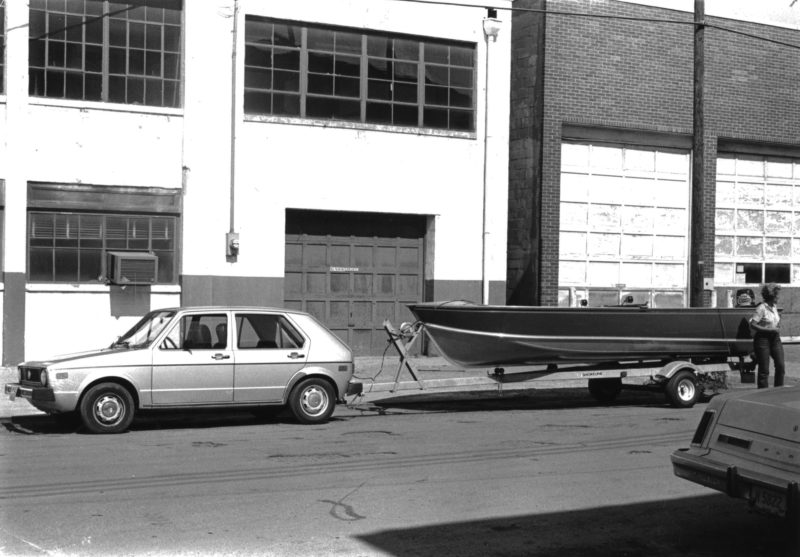 Photographs collection of the author except as noted
Photographs collection of the author except as notedOn delivery day in Ohio, TORNGAT all but dwarfed our little VW tow car. During her working life, TORNGAT was often towed by a VW loaded with camping gear and tools, along with four husky men.
I called the Lund headquarters in Minnesota and had a pleasant chat with a company official, who showed interest in our project right away. He answered my questions knowledgeably without trying to sell me a boat; his mainly positive replies were genuine. I asked how the boat was in rough water. “We sell most of our S-18s to Canadian fishing camps and Alaskan commercial fishermen who see plenty of nasty going.” What is the lowest-powered motor that would be enough for us? “The boat is rated for 55 horsepower, but a 25 should do the job in your circumstances.”
I was getting really interested, but then came the big question: How much will it cost? “You can have it delivered to our warehouse in Columbus, Ohio, for $1,400.” That was a sizable sum for our slim pocketbook but still a figure much less than expected. Columbus was a long distance from my home in midcoast Maine, and there was a major gasoline shortage in the Northeast, driving up the cost of filling the tank. Trusting my wife Dorrie would still speak to me when I told her what I’d bought, I said, “I’ll take it.”
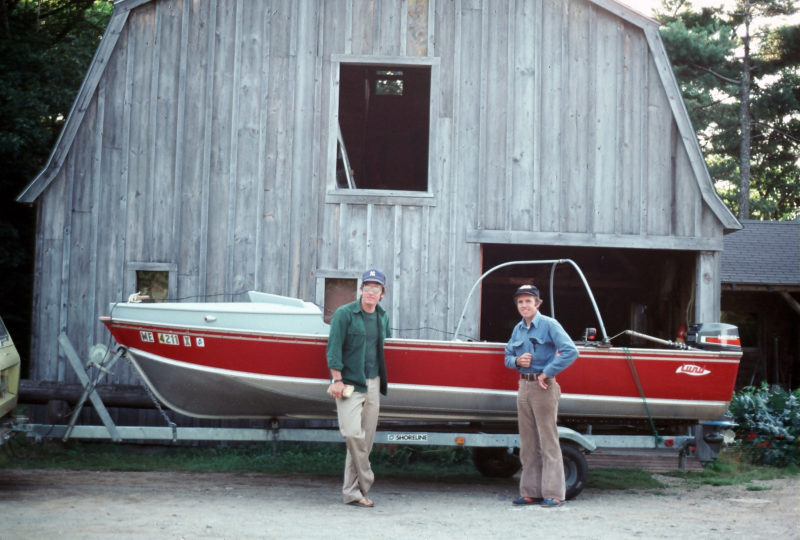
All ready for the North Country, the three companions—Geof Heath, left, TORNGAT, and I—pose for a family shot. With all of our modifications, our boat has lost its skiff appearance.
Dorrie and I were soon on our way to Columbus, by way of Rhode Island to borrow a boat trailer big enough for an 18-footer, and several days later arrived at the Lund warehouse. The S-18 looked awfully big behind my diminutive Volkswagen Golf, but it weighed only 400 lbs, so the little four-cylinder car engine had no trouble hauling the “whale” back to Maine.
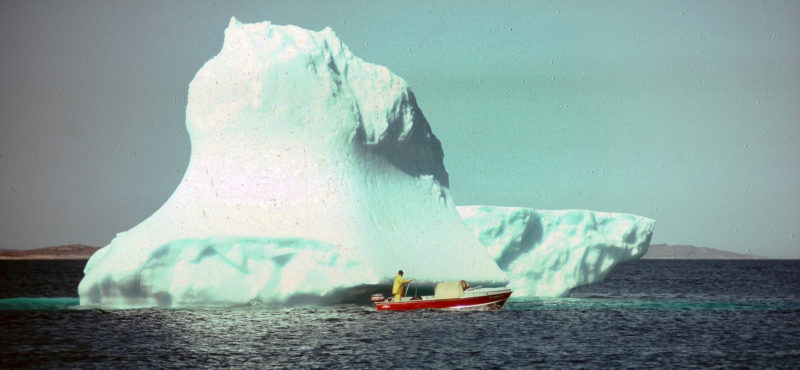
When you catch a big fish, you take a photo. When you pass a grounded iceberg, you do the same. The notorious Iceberg Alley passes down the Labrador coast just a few miles offshore; ’bergs often drift from the current and go aground on Labrador shallows. Geof and TORNGAT check one out.
Geof and I named the boat TORNGAT, after the range of mountains we were seeking in Labrador, and spent the rest of the year modifying the boat. I tested several different motors large and small and settled for a 25-horse Mariner, built by Yamaha in Japan. It proved a good choice then and for years afterward. Geof, skilled boat carpenter that he was, built a raised foredeck of plywood, pine, and fiberglass that bolted neatly into wooden channels he had fastened to the hull. Aft of this were fittings for three steel arches to support a light nylon canopy that would serve as our cabin. Our additions covered nearly half the length of TORNGAT.
I made and installed what turned out to be a tremendously valuable shoulder-high grabrail made of 3/4″ galvanized pipe. It offered support for safe passage while stepping over piles of gear and fuel containers between the helm and covered area. Grab rails, I knew from experience, are of great importance in rough water for both safety and comfort. Jarring boat seats can be torture to one’s bottom, but to stand in a bouncing small boat you need something solid to hang on to.
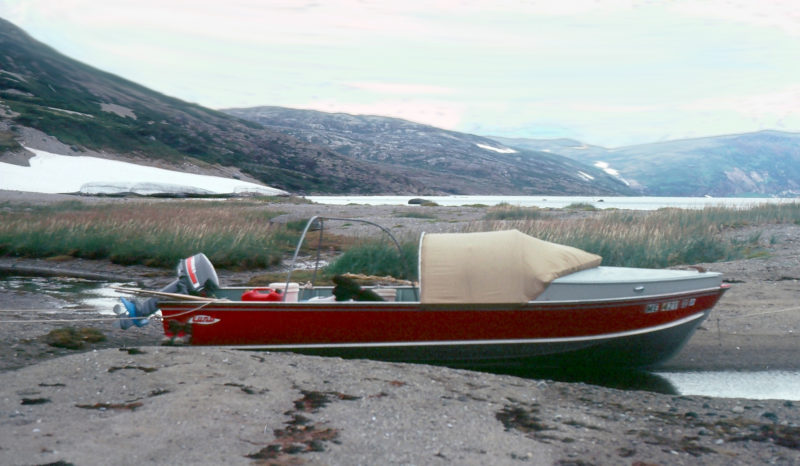
Carefully moored in Labrador’s Port Manvers wilderness, TORNGAT rested for a couple of days while Geof and I climbed nearby mountains. This was the farthest point we reached, 400 miles up the coast but still a bit shy of our goal. The melting snowdrifts in the background are evidence that we are in the land of short summers.
Building and rigging our exploration vessel—accomplished between working regular jobs for a living—carried through the winter of 1979–80. In July we set off on our venture in my International Scout with the boat and trailer in tow. This apparent late start was necessitated by the possibility of drifting ice. After leaving Maine, we towed our expedition boat across New Brunswick and Nova Scotia, ferried across Cabot Strait to Newfoundland, drove to the coast of the Strait of Belle Isle, ferried to Québec province, and then drove 60 miles of gravel road to Red Bay, Labrador, at the time the last coastal community north.
We parked the Scout in a fisherman’s field and launched from his rough log ramp. No trumpets, no sad farewells, only a “Have a good trip” from our fisherman friend, who stood at the top of the ramp shaking his head as we fired up the motor and headed out of the bay into a wall of fog.
For the next two weeks we motored up a coast that was fascinating but confusing, a jumble of islands, great headlands, deep bays that disappeared into the interior, and lovely “runs,” as long straits are called there, through miles of protected waters. We stopped at the very few isolated settlements for fuel, all the time enjoying a wild and beautiful country. Our speed averaged 10 to 12 mph, a reasonable pace in unknown and poorly charted waters but not with the zip to match modern go-fast craft. The Mariner 25 purred faultlessly at our usual three-quarters throttle setting. At that speed the motor used less fuel, the ride was more comfortable, and gave us the opportunity to take in our surroundings.
The coast in the early miles seemed to be an endless barrier of waves crashing against high ledges, rock-strewn flats, wall-like cliffs, and foaming reefs. But what a change when we came up on the Wonderstrand—more than 30 miles of vast sand beach backed by low forest. Though marked on the chart with two sweeping curves, we were still unprepared for this spectacular feature so far from the sun-warmed beaches of the U.S. east coast. We found this seemingly peaceful scene of broad sand beach washed by combers of the Labrador Sea to be as intimidating as the cliffs and reefs behind us. For mile after mile there was no place to land, and the threat of taking a heavily laden small boat through a hundred yards of humping and breaking waves caused us to listen intently for the slightest miss in the outboard motor. It didn’t fail us.
We never did reach our goal of climbing in the Torngat Mountains, although we did make it 40 miles north of Nain, the last year-round village on the coast. We just ran out of time while cruising 400 miles along a coast that seemed far larger than it appears on a map, dramatic and attractive in its variety. Our return down the coast was as interesting as the trip up, and we returned to Maine thoroughly satisfied with our adventure.
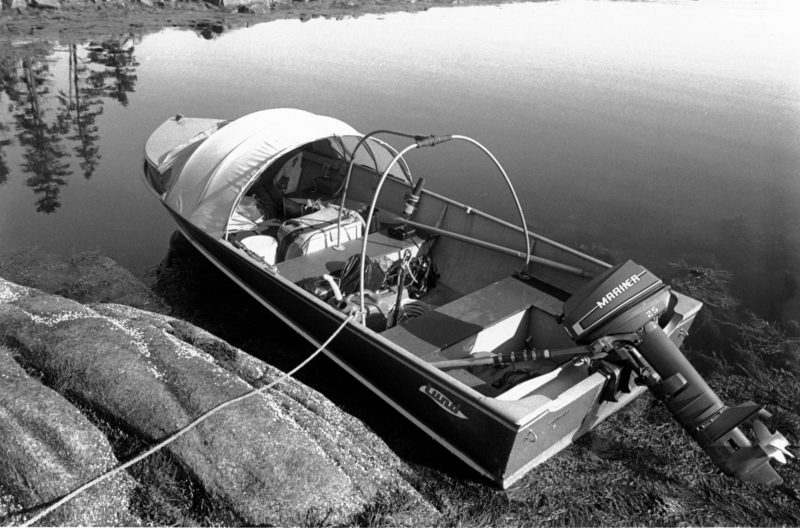
In her expedition mode, TORNGAT shows her long-distance layout. This photograph was taken after her return from Labrador—where she best fits, snugged up to shore on a Maine island.
For the Labrador expedition, we had transformed a simple hull into a capable cruiser with very little cost. The foredeck required a fair amount of boatbuilding skill, but all of the rest was straightforward cutting and bending of pipe and standard hammer-and-saw construction. Geof and I derived a lot of satisfaction in doing it ourselves and getting exactly what we wanted for our exploration of coastal Labrador.
It wasn’t the only transformation TORNGAT underwent.
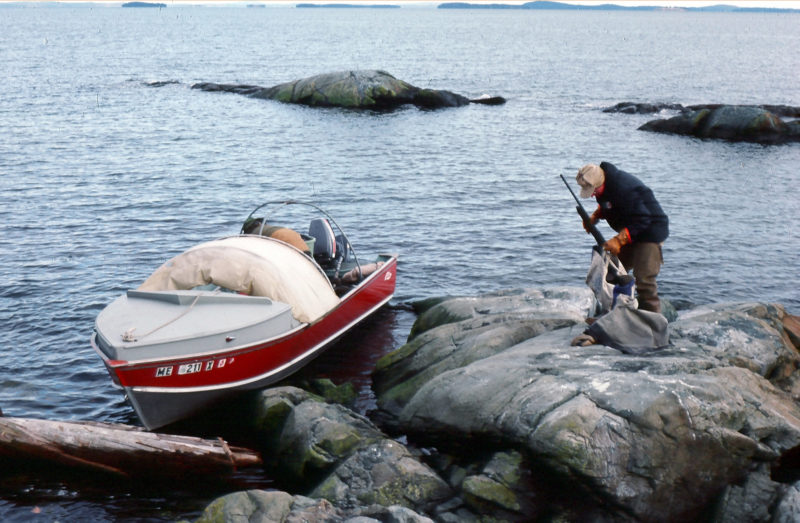
After Labrador, TORNGAT went into local use, and here she’s unloading a sea-duck hunter on a Maine coast ledge. The big skiff was always welcome transport in late autumn’s blustery days.
For the next few years, except for rare day outings along the coast, TORNGAT lay idle in my backyard much of the time while Dorrie and I were involved in other activities. Then, in the mid-’80s, I began part-time work with the Island Institute, a nonprofit organization that concentrates its work on the larger coastal islands of Maine where people live year-round. TORNGAT and I went to sea again, carrying work parties and supplies to various projects. The only major change we made from her expedition layout was to cut down the high grabrail to waist height. We usually left the three arches and the nylon canopy ashore because the frequent landings on rough shores required a person to slide over the foredeck onto rocks or ledges.
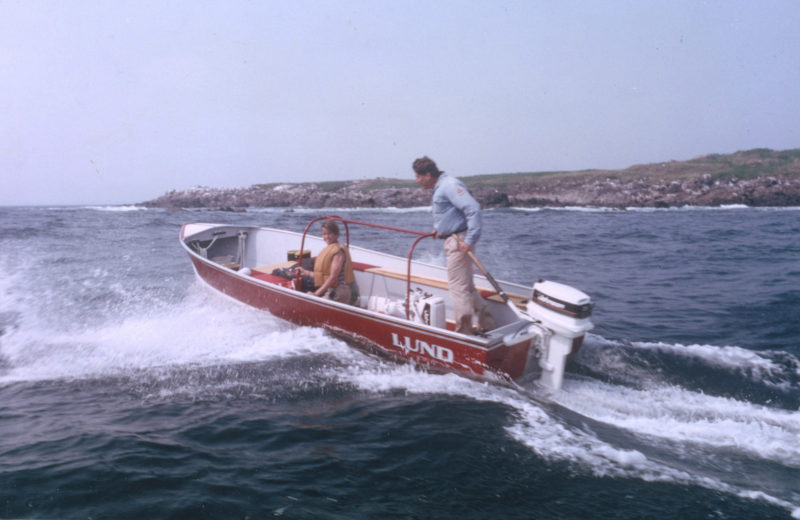 MITA
MITAAt relatively low cost, the S-18 as a pleasure boat serves well on ocean waters. Stuart and Ellen Dawson, associated with the Island Institute, give their Lund a workout in choppy going.
At this time, the State of Maine, and had sold scores of larger islands to private owners but still owned approximately 1,500 small islands. Wondering if there might be some recreational value in the islets it was still stuck with, the state hired the Island Institute to check them out.
The first year, Institute staffers visited islands from Portland to Rockland using a boat that was considerably larger than a skiff. They soon found that greater care was required to navigate in the shallows among the reefs and ledges; anchoring off and using a small skiff to go ashore was a time-eating drawback. Believing that a smaller craft might be more efficient, the Institute again hired me and TORNGAT to inspect state-owned islands from Penobscot Bay all the way to the Canadian border.
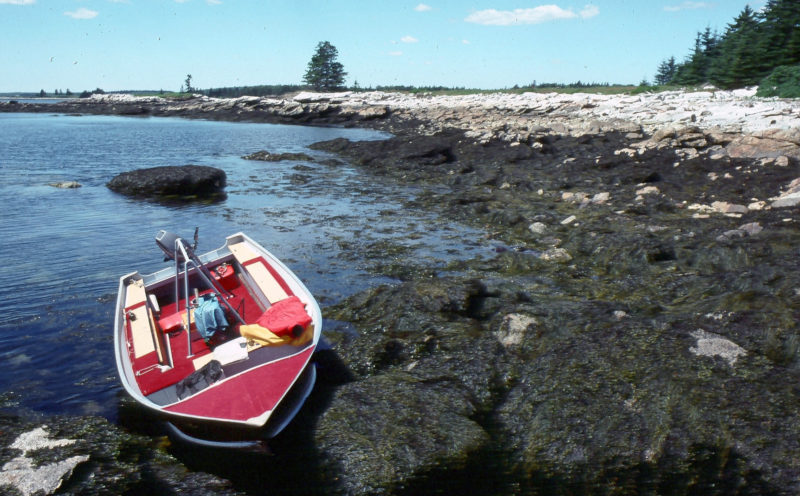 MITA
MITANot a wreck but just resting, an SSV-18 of the Maine Island Trail Association is grounded out while her crew works on an island campsite. The tough aluminum boats are ideal for this sort of work. MITA has had a fleet of four of them for 10 years, and expects at least another decade of service each of these boats.
This sort of work was old hat for a boat used to “wild dockage,” that is, dealing with all sorts of shore landings. In the course of a day, I might target three or four islands. Some that appeared attractive from the water lacked good landings and were rejected as unsuitable for public use. But occasionally real surprises waited in the rubble: small, even tiny, gems of rock rising out of the sea had narrow sand beaches and grassy flat spots where a small boat, canoe, or kayak could make a safe landing. A tent or two could be pitched under a windbreak of storm-toughened spruces and firs.
TORNGAT did her job without effort. Steering the outboard with its tiller assured instant maneuvering among rocks and weed, and the tough aluminum hull absorbed bumps without harm and could be grounded out for hours or overnight through the rise and fall of the tide without having a rock wear a hole in the bottom. And there was still room for camping gear and food. I spent countless nights on the islands and was not without a few creature comforts.
As the count of attractive, accommodating, and user-friendly state islands climbed, I was reminded of similar spots in Labrador. What a wilderness treasure right in our front yard! Scattered along much of the Maine coast, owned by the state and therefore safe from private sale and development, were many islands well protected from the open ocean by a barrier of other islands, and these new discoveries sired an idea: why not set up a “trail” of islands where boat travelers—especially small-boat adventurers—could overnight as they worked their way along this water trail? The Island Institute published a handsome annual magazine and, as one of the contributors, I wrote an article in the 1987 issue proposing such an island-studded waterway. The idea caught on.
Institute Director Philip Conkling and I discussed the possibility of setting up an organization of interested boat people within the Institute. I was given the task of setting it up, choosing islands, establishing campsites, etc., along midcoast Maine. Initially, TORNGAT was the only boat in the budding Maine Island Trail Association (MITA), and I was at work almost every day, often helped by a volunteer or two. We usually trailered TORNGAT to a boat ramp as near to the work site as possible. Loading food and hand tools in the boat, we would run to the island of choice, clear a simple campsite in a copse of spruce or fir, always trying to balance protection from harsh weather against locations with the best views. With TORNGAT so easily trailered, we rarely had to spend the night on an island, and her large size for her type meant that she could handle snorting afternoon southwesterlies without need for holing up for the night.
By the second season, it was clear we’d need more help and a second boat. The Institute purchased another S-18 to work alongside TORNGAT. Meanwhile, membership growth of the organization was rapid, and a full-time director came on board. In 1990, MITA spun off from the Institute and became its own nonprofit entity. We opened offices in Portland and Rockland, hired a field staff of three or so part-time assistants, and procured two Lund skiffs just for MITA. The organization was now ready to serve the growing number of islands in its care.
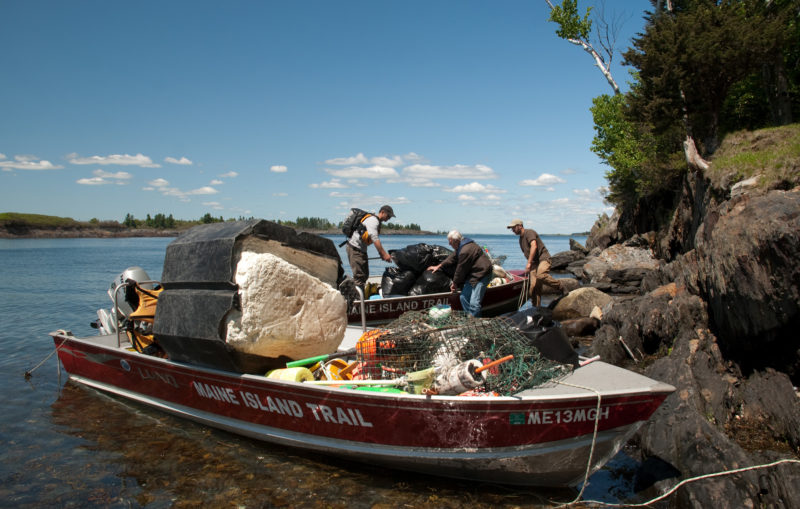 MITA/Eliza Ginn
MITA/Eliza GinnTwo MITA SSV-18s pick up a load of washed-up island trash for disposal ashore. The four large-capacity open boats do yeoman service along the length of the Maine coast on both state-owned and private islands in the trail.
Lund altered the basic design of the S-18 in the ’90s by changing to a shallow-V bottom and making a slight increase in beam, all of which added about 60 lbs of weight. This SV-18 then morphed into the SSV-18, but the original simple layout remained with only minor changes. MITA today has a fleet of four SSV-18s and has modified the boats with grabrails of various designs, side seats, lockers, and flat wooden floors. The grabrails are made and installed by MITA and the rest are added while the boats are being built at the Lund factory. Power for the skiffs is now 60-hp, tiller-steered Hondas.
All of these boats have been worked hard for a decade or more. Kept in top shape and manned by specially trained volunteers, these descendants of TORNGAT are not only used for regular island visits but also serve as waterborne pickup trucks during island cleanups, carrying ashore storm-wrecked lobster traps and other washed-up trash of all shapes and sizes for disposal. The open layout of the boats and their capacity of some three-quarters of a ton make them ideal for the job.
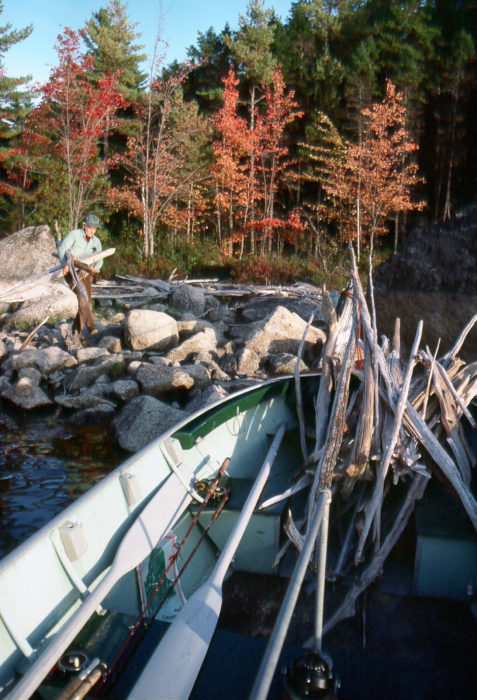
As a family fun boat, TORNGAT is often pressed into service for camping and fishing on Maine’s big northern lakes. Driftwood abounds along these shores, and a regular chore of setting up camp is gathering a good supply of firewood.
Although my boat and I were no longer busy with the work of MITA, I remained interested in its development. Then, in a move I eventually regretted, I sold TORNGAT to a MITA member and bought a 16’, lighter-weight Smoker Craft aluminum skiff and outfitted it with a 15-hp Yamaha four-stroke outboard. Its simple layout, like most tin skiffs, served me well for several seasons of lake fishing and camping. I had no complaints except, through no fault of the new boat, I missed TORNGAT. The feeling must have been mutual, because at a MITA stewardship party in Rockport I heard the siren call again, and off in a corner of the yard was a familiar hull sitting on a trailer. It was TORNGAT, showing the signs of her long life in paint scratches, dings and dents, and an overall scruffy look. I made a closer examination and found a sound body beneath time’s tarnish.
MITA Director Doug Welch said TORNGAT had been given to the organization by one of the association’s members, and he didn’t quite know what to do with the aging boat. He was readily agreeable to an even swap, my much newer Smoker Craft for TORNGAT. The younger boat could be sold for a good price to benefit MITA—and I could have the hulk of TORNGAT to do with as I saw fit.
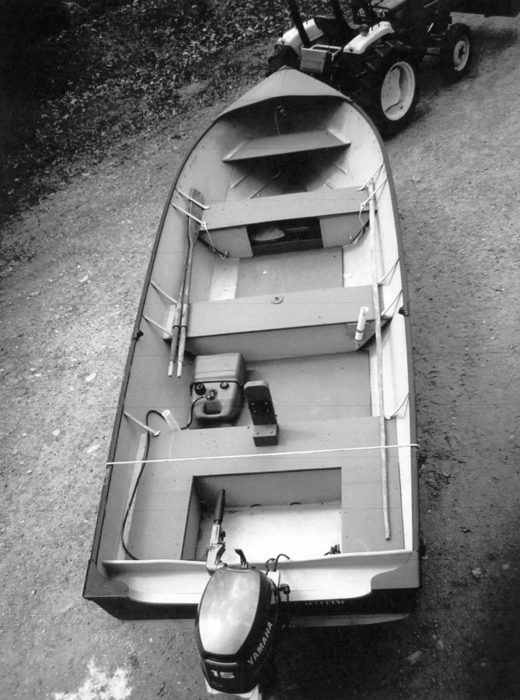
Recently restored to her former self, TORNGAT shows few traces of her working days. Gone is the pipe grabrail, which was to be replaced with a much smaller but very strong “chicken post” fastened to the seat in front of the boat driver. This is her current layout, roomy and open, as she is mainly used for freshwater activities.
Once TORNGAT was in my barn, I stripped her clean of grime and old paint and gave her a coat of dead-grass-colored paint on the outside. Inboard, I made removable plywood floorboards between the seats and took out the pipe grabrail, replacing it with a “chicken post” that I could hang on to while at the helm. I finished off the interior with gray paint. A question in my mind was what the 15-horse Yamaha, retained from the Smoker Craft, could do on an 18’ boat loaded with Dorrie and me and our camping, fishing, or sea duck hunting gear. Surprise. The motor can plane the big skiff with a sizable cargo or whisper at trolling speed while sipping fuel.
Despite her nearly 40 years of hard work, TORNGAT continues to serve on lake and sea. We have grown old together, but I can’t be restored with a coat of paint, so I have turned her over to my son-in-law so we can continue to fish and camp together.
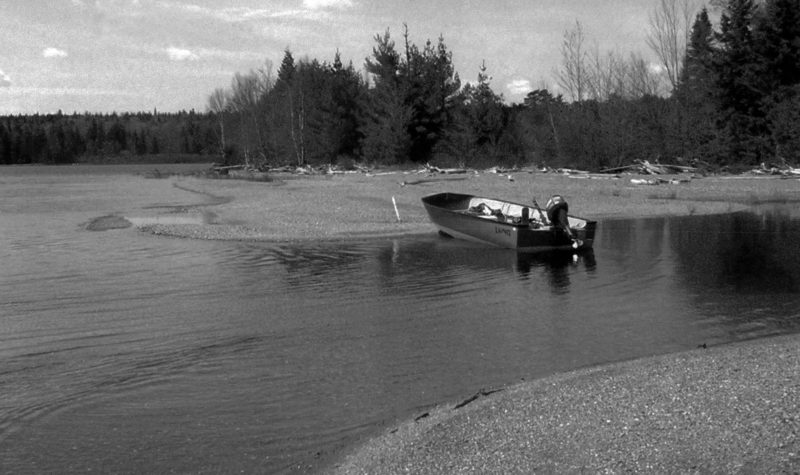
Hauled out on a gravel beach on Maine’s sprawling Chesuncook Lake, TORNGAT probably qualifies as a still-active dowager. Many years ago I traveled this same lake’s 25-mile length in a lumberman’s bateau powered by a smoking, old 5-hp Johnson outboard that seemed as ancient as the boat. How times have changed!
As for TORNGAT today, she can look back to some significant events. She is the boat that sparked the Maine Island Trail, the first of the modern water trails, which in turn inspired the development of some 500 other water trails in North America. As we say in Maine, that’s a “decent” record for a plain tin skiff that first proved her worth in the Labrador Sea.![]()
David R. Getchell, Sr. is a former editor of the Maine Coast Fisherman and National Fisherman, a writer and editor of several other publications, an active outdoorsman, and co-founder of the Maine Island Trail. An important partner in his work to establish the Maine Island Trail was Ray Leonard, an ecologist and field scientist, who was invaluable in evaluating details of the islands. Much of David’s writing has centered on boats and bicycles. He and his wife Dorrie live in a cottage they built by a pond in Appleton, Maine.
If you have an interesting story to tell about your adventures with a small boat, please email us a brief outline and a few photos.
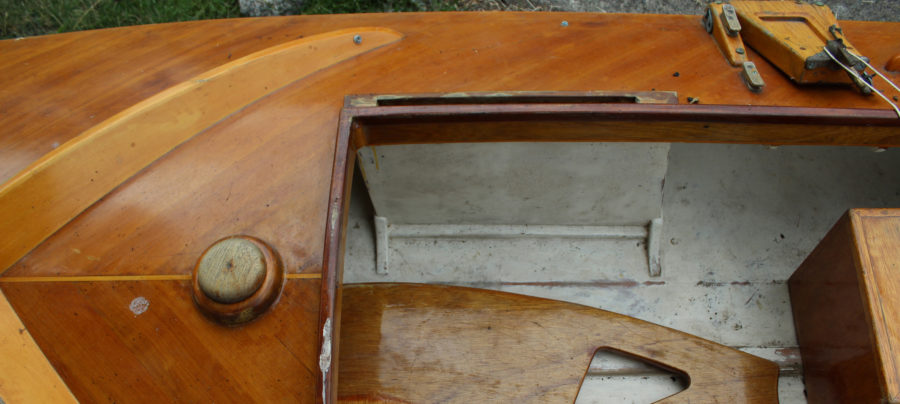
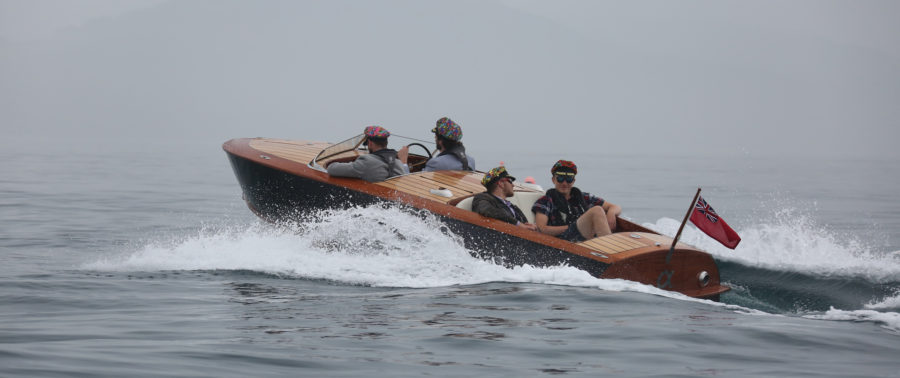
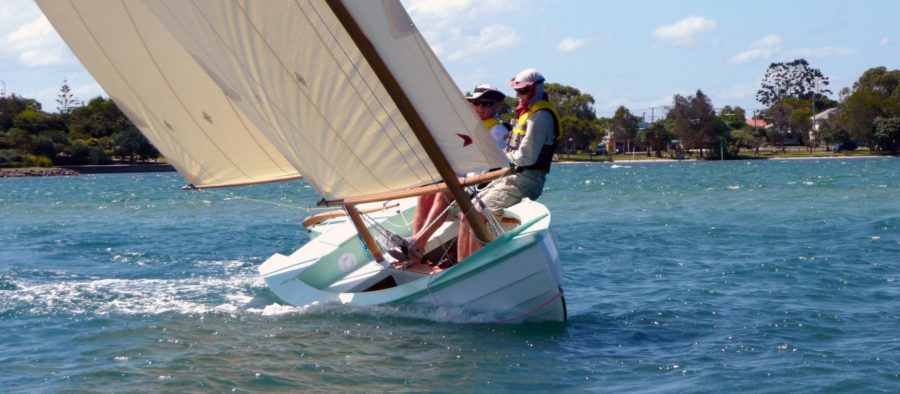

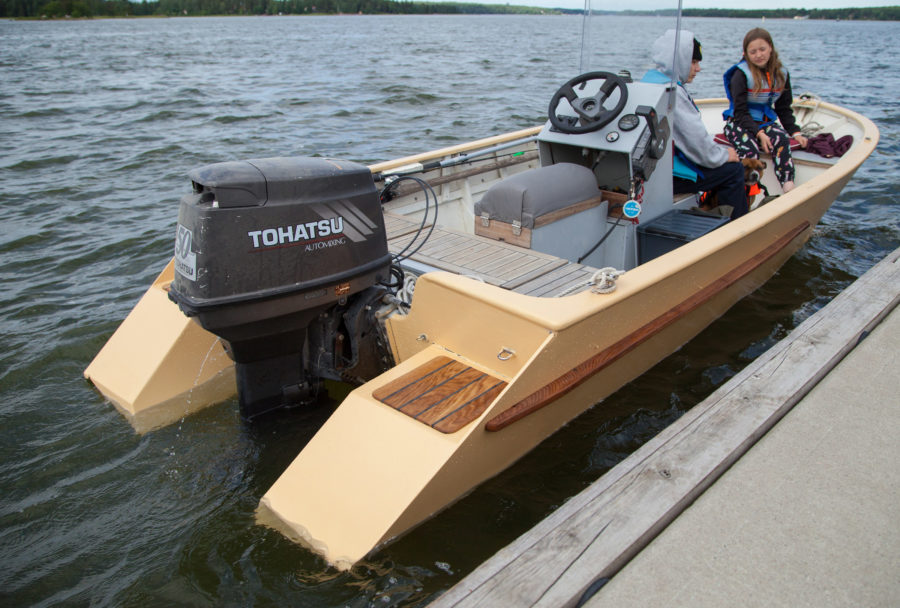
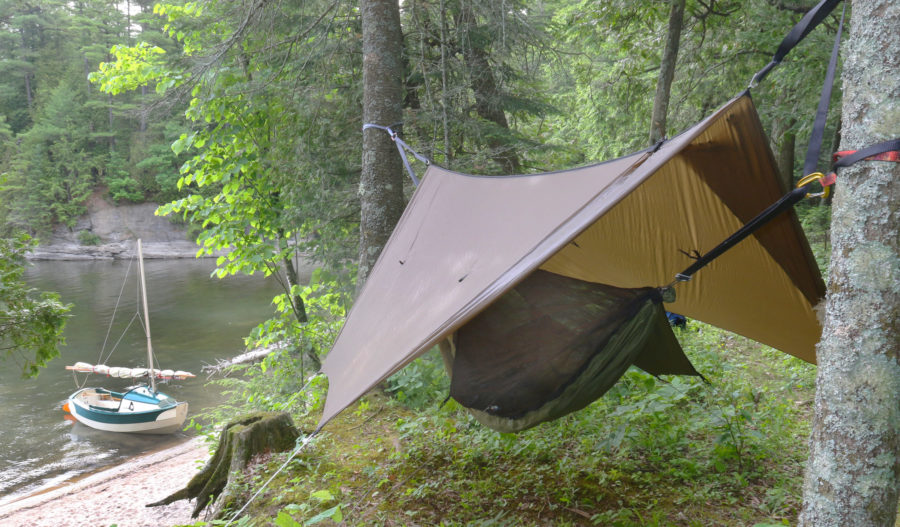
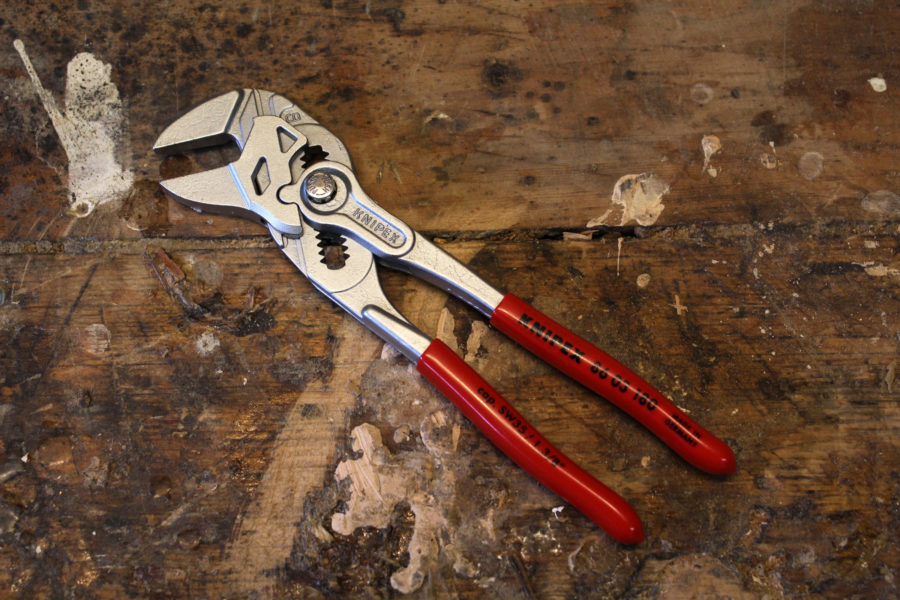
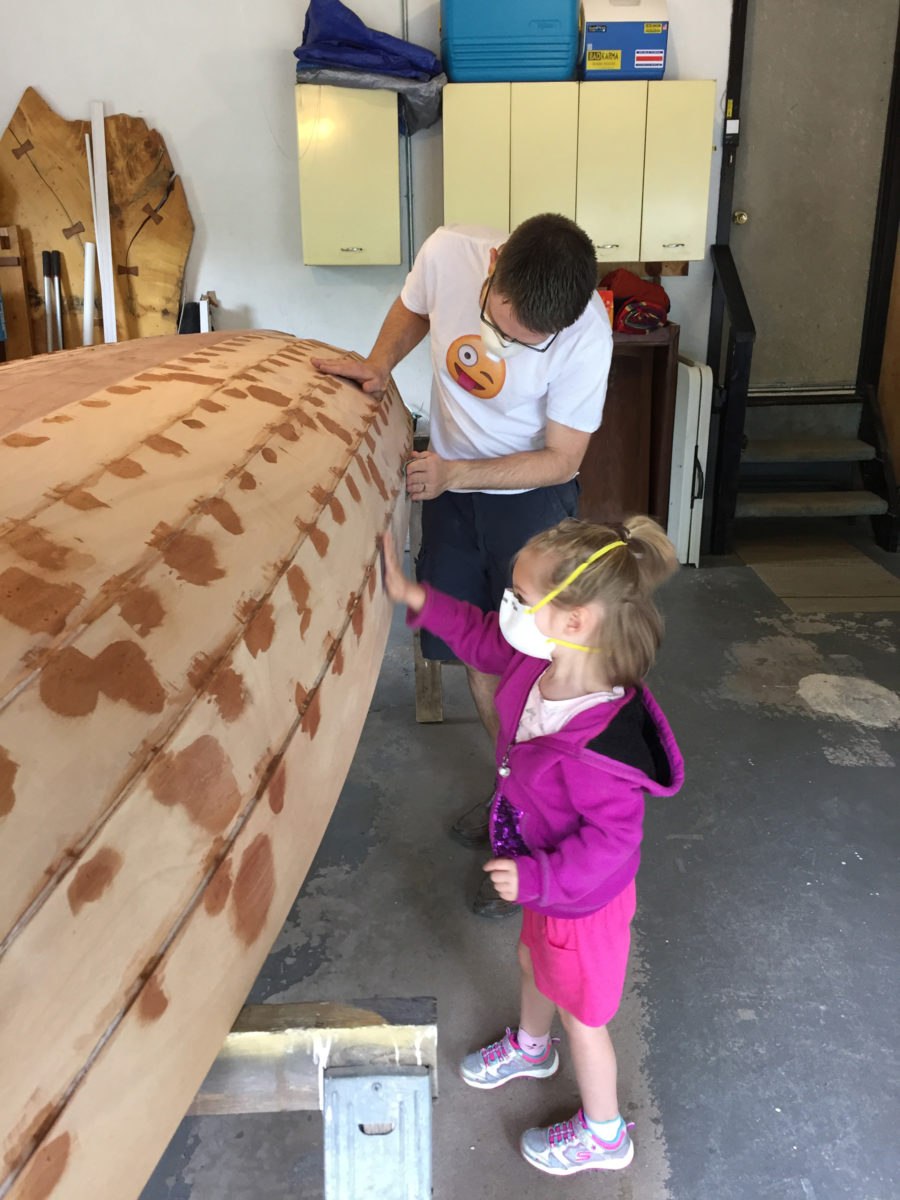
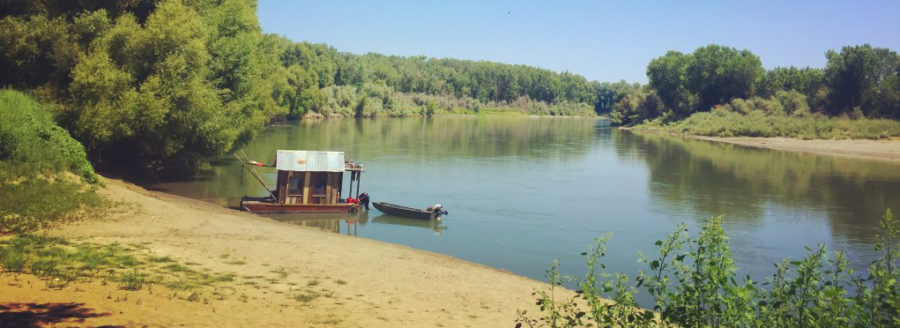
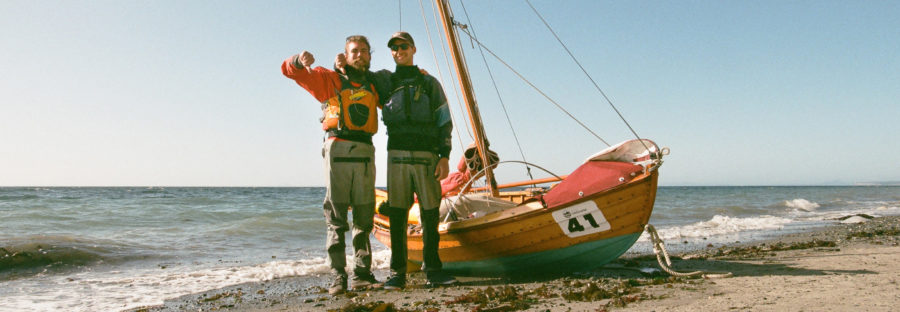
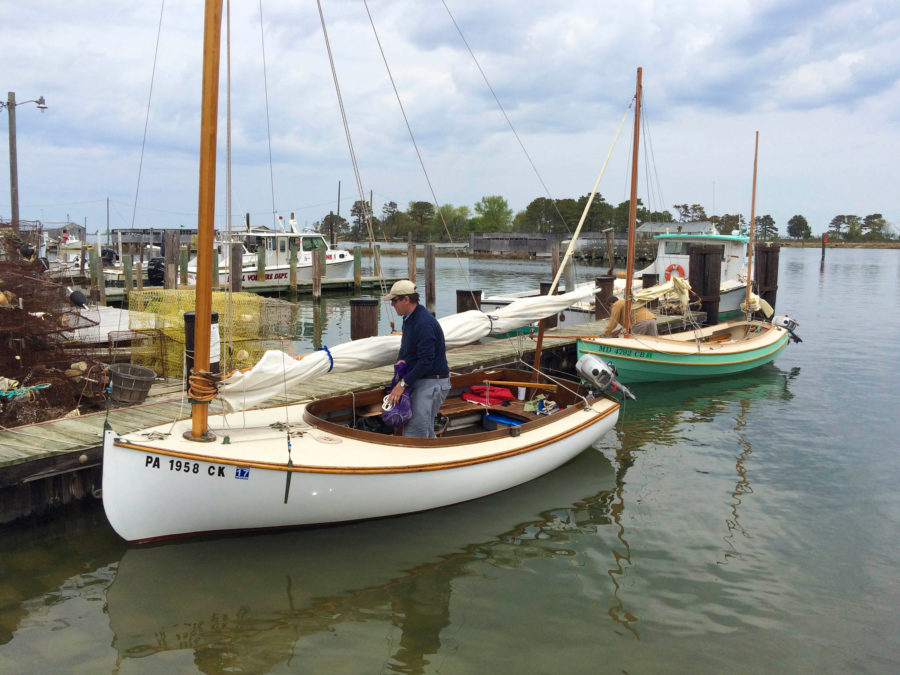
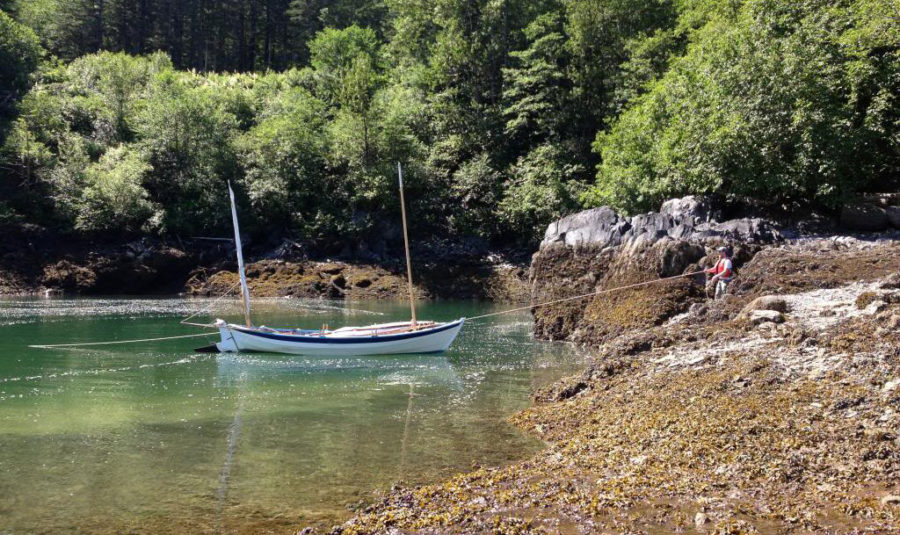
Thank you for the nice presentation of the story of TORNGAT, the tin skiff with a tale to tell. In gathering photos for the piece, I came across this rather mundane shot that is somewhat historic in the small-boat world. The photo shows TORNGAT about to leave Rockland on the second leg of the first complete trip over the newly formed Maine Island Trail. At left is Julie Canniff of the Island Institute, and Steve Spencer, right, of the Maine Bureau of Public Lands, both of whom figured prominently as hands-on representatives of their organizations in helping to create the trail. Historic, perhaps, but in any event, the three of us enjoyed several exciting days following this new water trail among Maine’s magnificent island treasury.
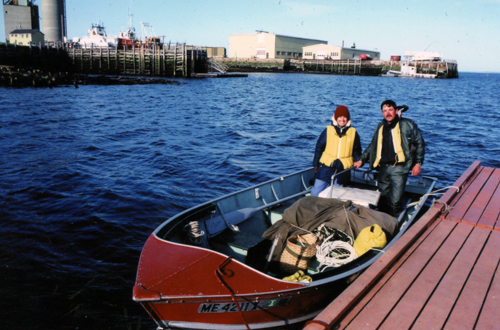
Nice piece. We are using 25- to 30-hp 4-strokes which will run you 18-19 knots with just a driver.
As former resident of Newfoundland, reader of National Fisherman and Small Boat Journal, I was familiar with David Getchell’s writing, and thus fascinated with his original account of exploring the Labrador coast in TORNGAT. This follow-up is a bonus with a happy ending.
I also remember him writing about the joys of using small, simple, economical outboard boats, a philosophy I share — even more now in my 80s and the limitations that imposes.
Great story. Glad to see a functional aluminum boat in these pages.
A short read allowed me to escape the concerns of life in the year 2020. Well written, it calls my inner self to stretch my life a bit and risk something that awakens my soul. Sad to lose this fellow as his kind of person is badly needed. I sincerely hope his wife, Dorrie, is well.
Such a lovely story of a boat that stretched across a well-lived career. So many stories here feature hand-built boats of beauty, but this story is a good reminder that a boat’s work qualities are just as important as its beauty or lineage.
Outboard Boater’s Handbook, edited by David Getchell, Sr., has been in my library for many years and enlarges on many of the topics he covers in his original article about his Torngat adventure. The book has been a good reference for me, and some enjoyable reading. I highly recommend it to those who are not already familiar with it.
I read this article in SBM right after it was written. I really enjoyed seeing it again. May Dave and TORNGAT be cruising the unknown journey together.